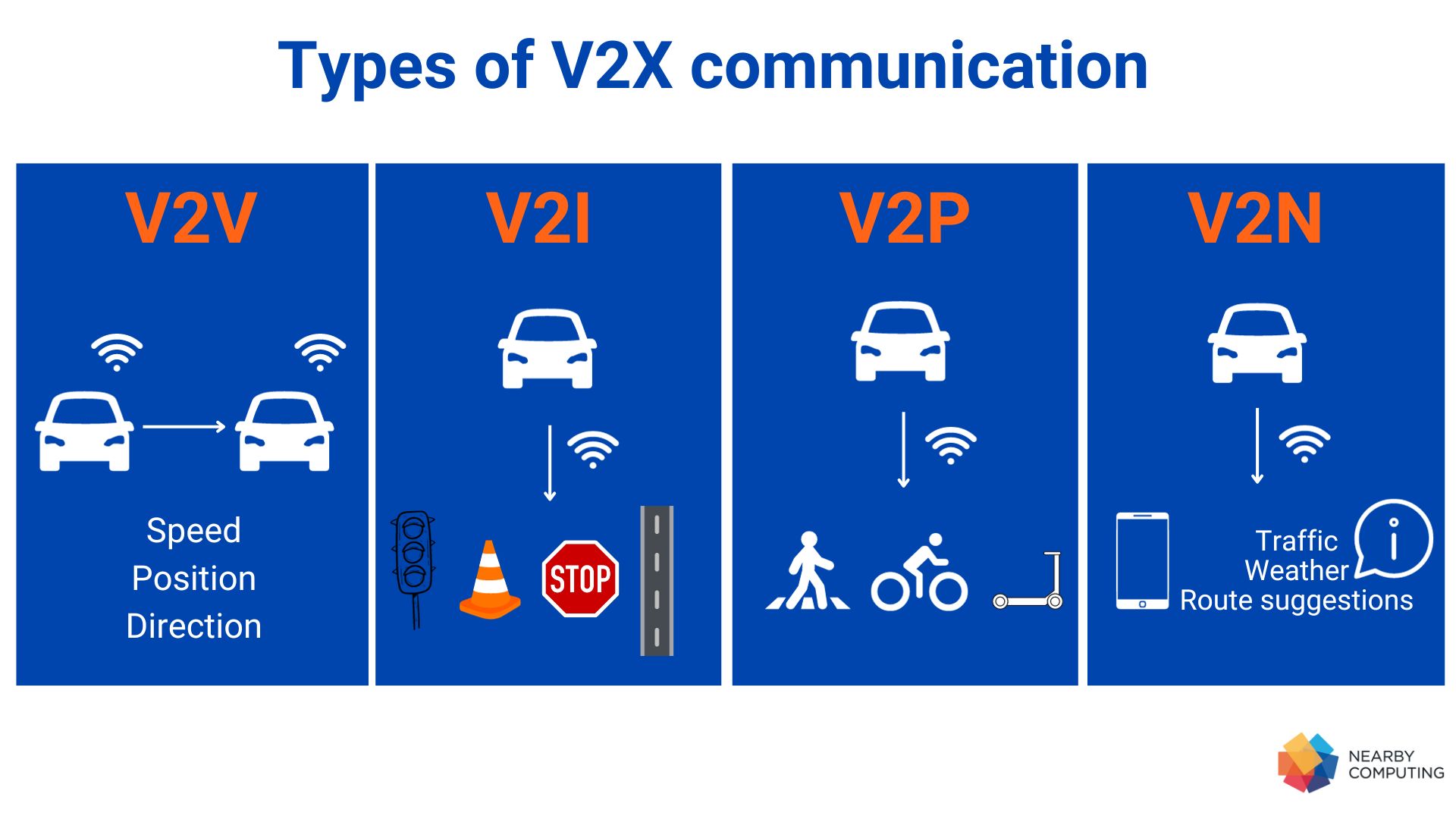Blog | nearby computing
V2X Technology: Revolutionizing Safe and Efficient Transportation
As automotive technology has rapidly evolved, touchscreens and advanced infotainment systems have become integral to modern vehicles (V2X technology). These systems, with their interactive displays and multifunctional capabilities, allow drivers to easily access features like navigation, media playback, and climate control. However, the horizon of automotive innovation extends far beyond touch-enabled interfaces, and the next leap forward is already upon us.
Envision a future where your vehicle isn’t just periodically updated via the cloud, but actively communicates with surrounding vehicles, infrastructure such as road signs, and broader information systems. This interconnectedness would provide your vehicle with a comprehensive, real-time understanding of its environment. For instance, by tapping into data from nearby vehicles detailing their speed, trajectory, and proximity, your car could proactively identify potential hazards and adjust its course accordingly. Similarly, real-time feeds from road signs and traffic management systems could keep you informed about ever-changing road conditions, detours, or emerging hazards.
Enter V2X technology—short for “vehicle-to-everything”—a groundbreaking innovation fostering seamless interactions between vehicles and virtually everything in their surrounding ecosystem. By harnessing V2X, we stand on the precipice of realizing significant enhancements in road safety, energy efficiency, and traffic flow.
Delving into V2X Communication Modalities
V2V (Vehicle-to-Vehicle): At the core of V2X is V2V communication, which facilitates the data exchange between vehicles. By constantly sharing vital metrics such as speed, location, and direction, vehicles can pre-emptively identify potential collisions, synchronize movements, and ensure optimal spacing between one another.
V2I (Vehicle-to-Infrastructure): This modality allows vehicles to seamlessly interface with built infrastructure components, like traffic signals or embedded roadway sensors, optimizing the flow of traffic and ensuring adherence to road regulations.
V2P (Vehicle-to-Pedestrian): Prioritizing the safety of pedestrians, cyclists, and other vulnerable road users, V2P focuses on the nuanced interactions between vehicles and those on foot or two wheels.
V2N (Vehicle-to-Network): Bridging vehicles with larger communication grids, including cellular and Wi-Fi networks, V2N empowers vehicles to tap into real-time data streams, from traffic congestions to weather forecasts, making each journey safer and more efficient.
As we navigate the fast lane of automotive innovation, V2X promises to redefine the boundaries of safe and efficient transportation.

Benefits
By enabling seamless communication, V2X technology can significantly enhance road safety, reduce traffic congestion, and improve overall transportation efficiency. V2X has the capability to mitigate accidents caused by human errors, alert drivers to potential hazards, and optimize traffic flow by coordinating with traffic management systems. Some of the benefits of V2X technology are:
Improved road safety: V2X enables real-time communication between vehicles, infrastructure, and pedestrians, providing valuable information about other vehicles, hazards, and potential collisions. This enables drivers to make better-informed decisions and can also enhance the capabilities of advanced driver-assistance systems (ADAS).
Traffic efficiency: V2X technology allows for better traffic management and optimization. Vehicles can communicate with traffic lights, road signs, and traffic management centres to determine the most efficient routes, reduce congestion, and improve traffic flow. This results in time savings for drivers and reduces fuel consumption and emissions.
Enhanced Mobility: V2X technology can provide drivers with greater situational awareness, alerting them to potential hazards that may be difficult to see, such as vehicles in blind spots, pedestrians in low-visibility situations, or upcoming traffic jams.
Support for autonomous vehicles: V2X plays a crucial role in the development and deployment of autonomous vehicles. It provides vehicles with real-time information about their surroundings, enabling them to navigate complex traffic situations and make informed decisions. This technology is essential for the safe and efficient operation of autonomous vehicles.
Environmental Benefits: By optimizing traffic flow and reducing congestion, V2X technology helps reduce fuel consumption and emissions. This contributes to a more sustainable and environmentally friendly transportation system.
Facilitating smart cities: By integrating vehicles with city infrastructure and networks, V2X can play a significant role in developing smart cities, enabling better management of traffic, public transportation, and urban planning.
Several challenges hinder the widespread implementation of Vehicle-to-Everything (V2X) technology, with the most significant issue being the efficient processing and transmission of massive amounts of data over communication networks. Low latency is a requirement for V2X to operate efficiently. Edge computing is the only solution to reduce latency and bring data closer to vehicles and resources. Platforms like NearbyOne can automatically address this issue by providing robust processing, reliable storage, and real-time communication.




